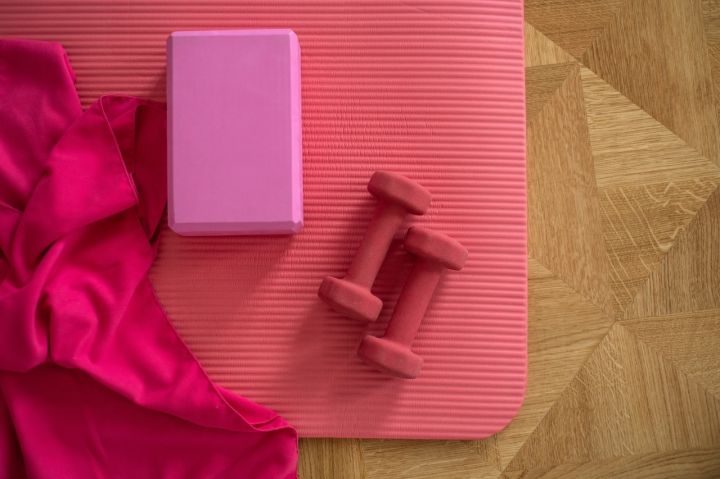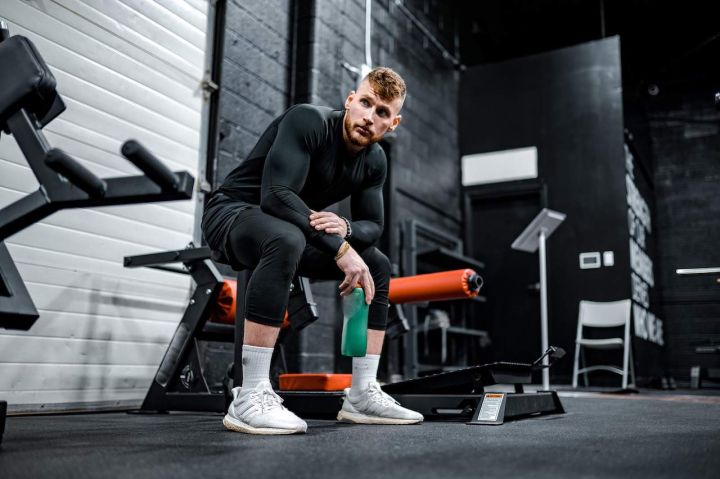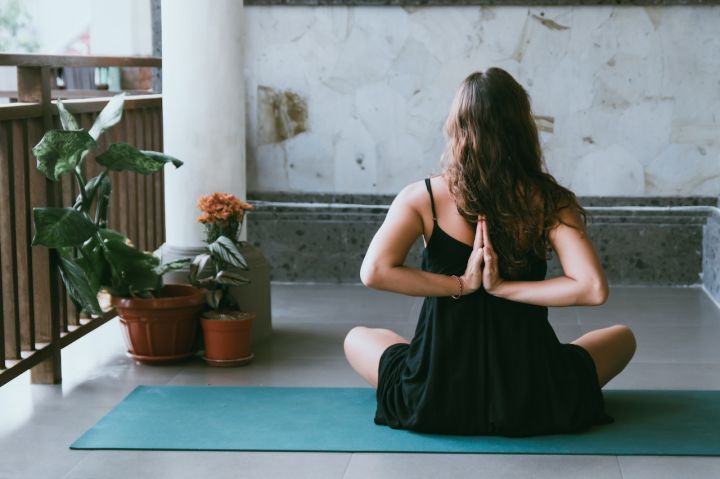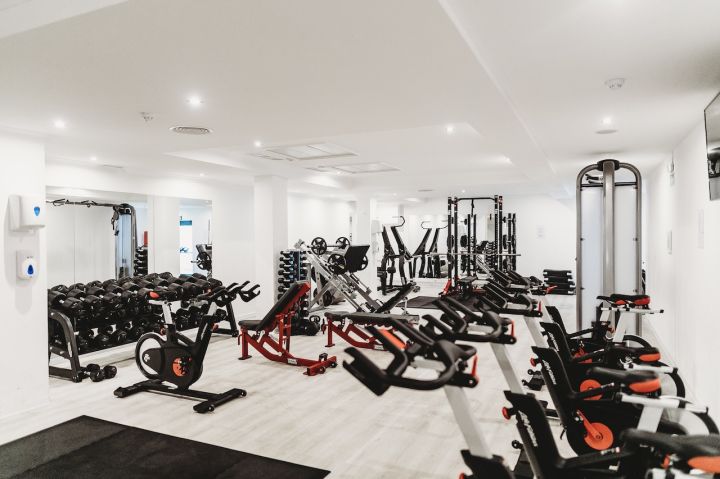A friend of mine is going to learn yoga, in the month before the official start, she received more than twenty couriers one after another, open it, all yoga supplies, in addition to a dozen sets of spring, summer, autumn and winter yoga clothing, there are yoga bricks, yoga pillow, yoga stretching belt, yoga ball, yoga gloves socks headband wrist and knee pads, yoga mat, yoga towel, yoga pavement towel, yoga pillar, massage bar, etc., see people's eyes are blurred. In addition, we also bought a number of yoga-related books and electronic version of yoga music.
So we practice yoga, do we really need to prepare so many things, what are all these things for? What should we do if we are not prepared?

Using door frames to strengthen backbends and hip openers
First of all, the items that must be prepared for practicing yoga.
Yoga clothes: The so-called yoga clothes do not refer to a specific style, brand, fabric clothing, either elastic tight yoga clothes or traditional wide yoga clothes can be, as long as it does not hinder the movement of the limbs during the practice and does not hinder the excretion of sweat. Of course, if you are practicing with everyone in the yoga studio, you should also pay attention to the aesthetics. Yoga clothes also do not need more, there are two or three sets of replacement can be, if is to carry out intensive training, generally need to use four sets a day, always can keep the practice before the yoga clothes clean.
Yoga mat: Yoga mat is spiritual, it witnessed the owner's daily diligence and efforts, accompanied by the owner progress, accompanied by the owner to negotiate the asana. It lies quietly without words, but you will be familiar with it and find a more comfortable feeling in its body. So even if you go to the pavilion to practice, practitioners had better bring their own yoga mat.
Yoga towel: No matter what type of yoga practice, after the end, generally have to lie down for a while to do resting art, this time generally have to cover the yoga towel. Even in the hot summer, just after a sweaty asana practice, you should also cover your body, not to let the hot body suddenly cool down because of stopping the practice, but to let the body slowly adjust to a balanced state.

Using the wall to open the shoulders
Towel: Whether or not you prepare a towel depends on what you are practicing. If it is an exercise that will make your body sweat a lot then a towel is needed. When the sweat will blur your vision, and when the sweat makes your body too slippery to do support postures, you need a towel.
If you are a devout yogi and intend to stay on this path, it is also important to read the classical books on yoga. The rest are not necessary to have.
The rest of the yoga supplies, of course, have their uses, especially in iyengar yoga and physical therapy yoga. They help people with stiff limbs to flex their bodies, give support points to people with insufficient strength, etc. For example, the backbend is not good, you can use the yoga ball, lie on it, as the body's ability to increase, slowly roll to adjust their backbend amplitude; shoulder stiffness, you can use the stretch belt to do shoulder ring to increase the flexibility of the shoulder joint, elbow inversion support when the big arm is easy to spread to the sides, you can first use the stretch belt to measure the distance, set on the big arm; yoga brick is more widely used, the hip stiffness tight plate sitting can sitting on them, ashtanga front jump can also use yoga bricks to measure, increase the height of the jump and so on. Of course, these yoga supplies are not just the uses listed above, they have a wide range of uses, but in the end, they are all assistive devices.
Progress is faster and easier with aids, but it's not necessary and progress can be made without them.

First of all, yoga itself has a lot of spine flexibility, strength strengthening asanas and joint activities.
If your joints are not opening up well enough, then joint activities should be done every day. This is the foundation of the foundation, and even if you have to use assistive devices, you still need to have joint activities to prepare the ground.
Some asanas have a targeted practice role, for example, strengthen the practice of reverse boat pose, can open the armpit, increase the backbend space, ready for the wheel pose; 45 degree boat pose and 30 degree boat cross practice, strengthen the core strength, you will find the ashtanga front jump is also quite simple; hands behind the body interlock up, on the shoulder joint stiffness, hunchback has a significant improvement effect. And so on.
Secondly, we can use the objects around us to perform auxiliary exercises, which is more convenient than carrying too much auxiliary equipment with us.
Chairs, walls and door frames are the most used in yoga practice. For example, at the beginning of half handstand, a leg distance from the wall, one leg up and one leg stomping on the wall, can eliminate the fear of inversion, find the feeling of inversion; sit on the bones as a folding point, the upper body, arms a line, and the wall at right angles, push the wall, can help open the shoulder joint; hands grasp the door frame, push the chest forward, can strengthen the backbend; sit on a chair, legs on one side, hands holding the backrest of the chair and twisting to the other side can deepen the twist, and so on.
The earliest yogis practiced without even a mat. It was not only because there were none, but also because yoga places great importance on the "Root", that is, the human foot. It is believed that the feet are in direct contact with the earth and receive the support and energy of the earth. Yogis know the "Eight branches", the second step of which, "Internal control", means contentment, austerity, and purification, not to live a very miserable life, but to restrain material desires and take only the minimum needs of life. Similarly, when practicing yoga, we don't need too much preparation, we can get rid of our dependence through our own efforts. For example, if you are afraid of slipping on the mat and wearing yoga socks and yoga gloves, it is better to strengthen your core and learn to grip the ground. When the core strength is strong enough, also learned to "Grip the ground", then "Slippery" Also does not exist.

For example, when i was learning yoga, i only had a few sets of replacement yoga clothes, yoga mats, yoga towels and a few books. As my practice progressed and deepened, doors, walls, etc. Could no longer meet my in-depth needs, i prepared yoga bricks and stretching straps, more books; only after i started leading classes did i prepare some auxiliary equipment one after another, but in fact, after observing my students, i found that using objects such as walls were instead more conducive to practice, using auxiliary equipment such as pillows were instead not concentrated enough, and she might repeatedly choose and adjust them, which she may choose and adjust them repeatedly, which interferes with her own practice state. As for background music, i never use it for my own practice, because i want to listen to my own breath and feel my own inner being. But when i lead a class for my students to do rest techniques, i will play background music to help them relax.
For general practitioners, it is not recommended to have all the auxiliary equipment at the beginning, but to prepare the most basic ones first and add them as you progress, so that some items do not pile up prematurely and add trouble every time you organize your home.





